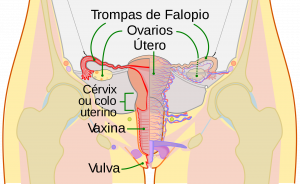Among the thousands of infections and diseases that can affect the female reproductive system, some cause confusion and surprise upon hearing about them, especially when receiving a diagnosis, such as pelvic inflammatory disease. In this article, we will clarify what it is, its main causes, symptoms, and recommended treatments for this disease that haunts women.
What is Pelvic Inflammatory Disease?
Pelvic inflammatory disease, also known as PID, is a serious infection that affects the female reproductive system, including the uterus, ovaries and fallopian tubes. It begins in the vaginal area and, as it progresses, reaches other organs, affecting the entire pelvic region and, in its most advanced stage, can spread through the abdominal area. If not properly and promptly treated, it can cause irreversible damage to the woman, including infertility. This disease most often affects younger women and sexually active teenagers who have frequent changes in sexual partners, do not usually use condoms during sexual intercourse, and also practice vaginal douching, frequently washing the inside of the vagina. PID is considered a sexually transmitted disease, but it can also occur because a patient has endometriosis. Pelvic inflammatory disease is classified by degree and severity in the patient.
- Stage 1 classification – inflammation affecting the endometrium and fallopian tubes without involving the peritoneal area;
- Stage 2 classification – inflammation affecting the fallopian tubes and also the peritoneal area;
- Stage 3 classification – inflammation affecting the fallopian tubes and blocking the tubal area, leading to an intact abscess in the area;
- Stage 4 classification – inflammation with a ruptured tubo-ovarian abscess or the presence of pus in the abdominal cavity.
Symptoms of Pelvic Inflammatory Disease
Pelvic inflammatory disease can occur silently, subtly, and often with no symptoms, which makes diagnosis difficult and puts women at greater risk. The absence of symptoms does not lessen the severity of the disease, nor the chances of it getting worse. For this and other reasons, it is essential for women to maintain regular gynecological checkups and to know their bodies and how they function in order to notice any unusual signs or symptoms. The main symptoms to look for if you have pelvic inflammatory disease include:
- Pain in the lower abdomen when palpated;
- Vaginal bleeding outside of the menstrual period;
- Bleeding after sexual intercourse;
- Vaginal discharge that is yellowish or greenish with a strong odor;
- Pain during sexual intercourse;
- Fever of 38⁰C (100.4°F) or higher.
Other symptoms have also been observed in women with PID, including nausea, chills, and intense pain in the lower back. If you notice any of these symptoms, seek emergency care or see your gynecologist as soon as possible. Delayed diagnosis and proper treatment allow the microorganisms responsible for the disease to continue multiplying rapidly and reaching deeper tissues of the reproductive system. On that note, I want to share a tip for our readers who are trying to conceive: did you know that Patricia Amorim, in partnership with the company Famivita, developed a line of products to help couples who are trying to get pregnant faster? Among them are important vitamins for female and male fertility such as FamiFerti and ViriFerti, as well as ovulation tests, fertility-friendly lubricant that mimics cervical mucus, and everything you need to give an extra boost for a positive result soon. You can find all the products and the trying-to-conceive kit option here in our online store.
Main Causes of Pelvic Inflammatory Disease
Some situations and diseases can lead to pelvic inflammatory disease, which is why it can also be considered a sexually transmitted disease. But it is not only through unprotected sexual intercourse that it can happen. The main causes in general are:
- Unprotected sexual intercourse with multiple partners;
- Sexually transmitted diseases such as gonorrhea and chlamydia;
- Contamination during childbirth;
- Use of contaminated objects for masturbation;
- Endometrial biopsy or during uterine curettage procedures;
Therefore, it is concluded that pelvic inflammatory disease is caused by specific bacteria that come into contact with the vagina. These bacteria multiply quickly, reaching other tissues of the female reproductive system and causing symptoms — or not — but it can be diagnosed through routine gynecological exams.
Disease Diagnosis
The diagnosis of pelvic inflammatory disease is not always easy or quick due to the absence of symptoms. However, it is possible to detect it through blood tests and imaging exams such as pelvic ultrasound and transvaginal ultrasound. In blood tests, the disease can be detected by analyzing C-reactive protein or an elevated erythrocyte sedimentation rate. The presence of chlamydia and gonococcus diseases are also strong indicators.
Treatment of Pelvic Inflammatory Disease
After the gynecologist’s diagnosis through evaluation tests, treatment should be started. Treatment consists of oral or injectable antibiotics that are administered intramuscularly for a course of 14 days. In addition to medication to fight the disease, some care and recommendations should be strictly followed, such as:
- Rest during the days of treatment;
- Do not have sexual intercourse, even with a condom, during treatment;
- If using an IUD, its temporary removal is recommended;
During the patient’s treatment, it is recommended that the partner or sexual partners are also treated, even if they have no symptoms. Treating the partner will prevent reinfection of the patient through sexual intercourse after the end of treatment. If left untreated, pelvic inflammatory disease can cause serious and often irreversible problems for the patient. Infertility is one, as well as the risk of ectopic pregnancy, where the embryo is implanted outside the uterus — possibilities for women suffering from PID. Photo: Elisardojm












